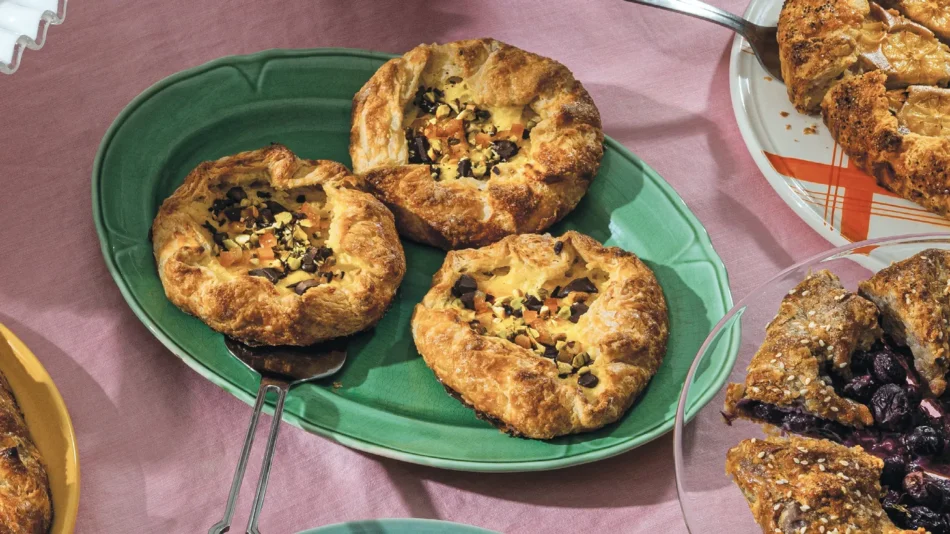Yes, Evan Kleiman is Los Angeles’s unofficial pie queen but these days, she admits that she rarely makes pies. Instead, she tends to make galettes, those pies that aren’t pies and have never been considered pies at KCRW’s Pie Contest. But let’s be real. They are so much simpler to throw together and more forgiving, which is a good thing for new bakers.
Food writer, recipe developer, and stylist Rebecca Firkser’s book, Galette: Sweet and Savory Recipes as Easy as Pie, takes us through the incredible range of this rustic, freeform tart.
Evan Kleiman: You know, I never have had a conversation about galettes. Because we’ve been so galette-averse for the pie contest, we never wanted to confuse people.
Rebecca Firkser: That is so fair. I mean, it’s a wide world of these fruit and vegetable-filled pastries. Whereas for me, I feel like I’ve been talking about nothing but galettes for the past two years, so I feel like we’ll even it out a little bit.
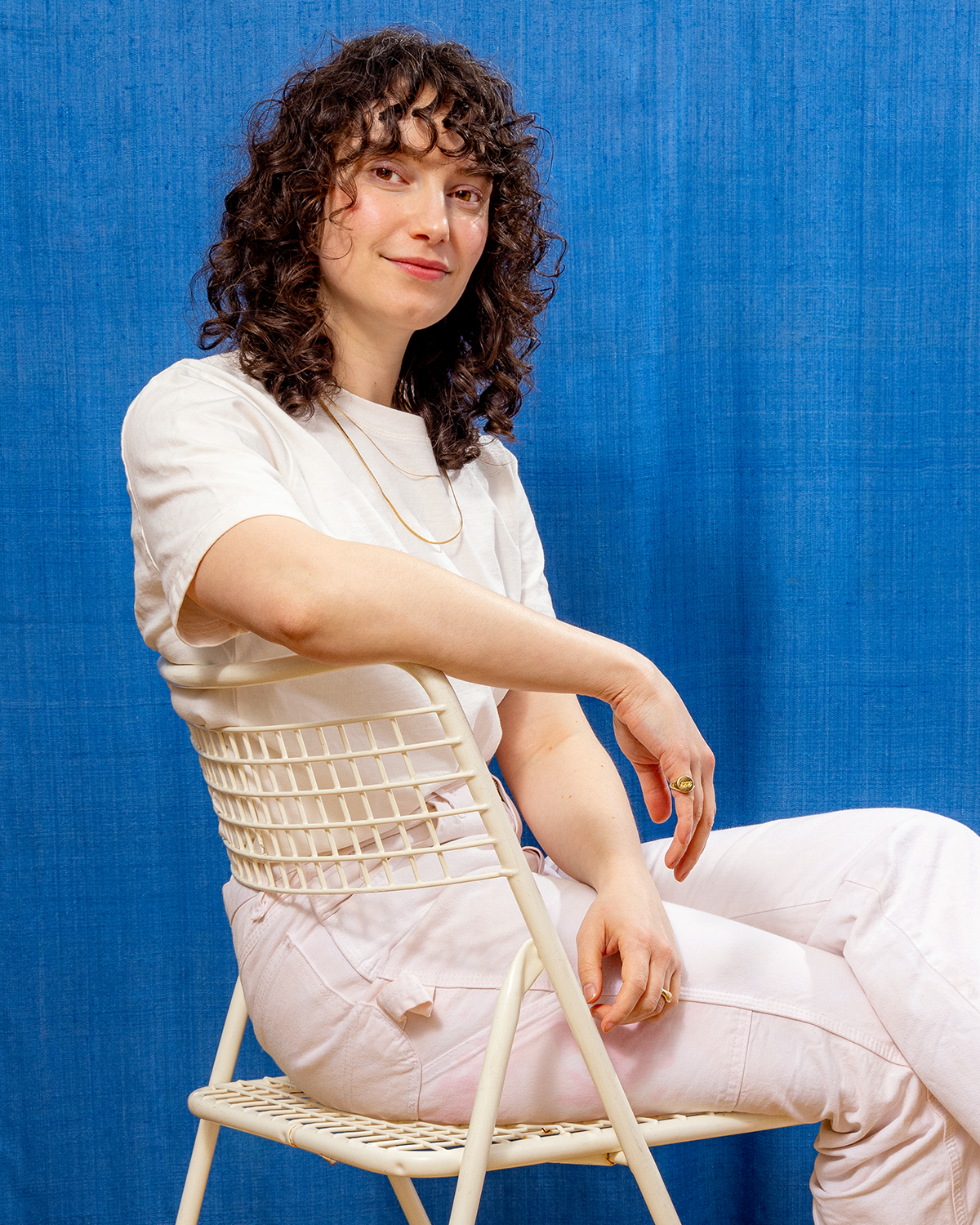
Rebecca Firkser, author of “Galette!” Photo by Jessica Marx.
Rebecca, you relate a story that I can so relate to in the introduction to your book that I really love. It’s pretty much about how lemons often turn into lemonade, even when you don’t expect them. Would you mind telling your story about the fresh Italian plum galette that you made?
Certainly. When I was in college, my senior year of college, I was a student of costume and scenic design and art history, and yet all I wanted to do was cook. I loved to bake for my roommates, so I went down to the local supermarket, which often stocked really beautiful produce, and I bought what I could with my meager work study wages. The cheapest butter. I had a pound of flour, and then just a few really gorgeous plums. Fruit can get so expensive but it was such a treat for me and my roommates. So I was like, I am going to turn this into a galette because at the time, I was quite intimidated by pies.
I rolled out a crust. I was quite timid with the pastry. I used a wine bottle because our apartment didn’t have a rolling pin. The fruit was a little bit soft. I was quite timid with the pastry, so I don’t think I worked the butter quite well enough into the flour, and all of those juices and butter came oozing out. I was so disappointed because all I wanted to do was impress my friends with this beautiful baked good, and then we cut into it, and it was wonderful. The crust was crisp, the fruit was soft, and I was like, oh, okay, maybe I can bake, and maybe galettes are the thing that I should be baking.
I love this so much. Maybe you could define what a galette is for us. I have been involved in countless arguments on the subject.
Gosh, I feel like I could have written 700 more pages about the intricacies of what is a galette but technically speaking, for this book at least, a galette is a flat, filled pastry. They date back many, many years, like perhaps even to the 11th century. The term comes from a dialect of Old French for flat cake. But, of course, the galette has evolved.
So for me, when I say galette, I mean the rustic, free-form pastry with a flaky shortbread crust. Then you pleat that crust a few inches over the top of your filling, and it can be filled with mostly produce, but you could use cheese or meat or many other fillings, as I explore throughout my book’s pages. But of course, you know, people refer to galettes as tarts. People refer to them as crostatas. People refer to them as just open-faced pies.
Then, of course, there are other baked goods that are also called galettes. It’s a term for a Breton crepe. It’s a term for cookies. It’s a term for even fry bread in certain parts of, I believe, French Canada. So the galette really just continues to evolve. But for the purposes of my book, we’re going with the rustic, open-faced pastry.
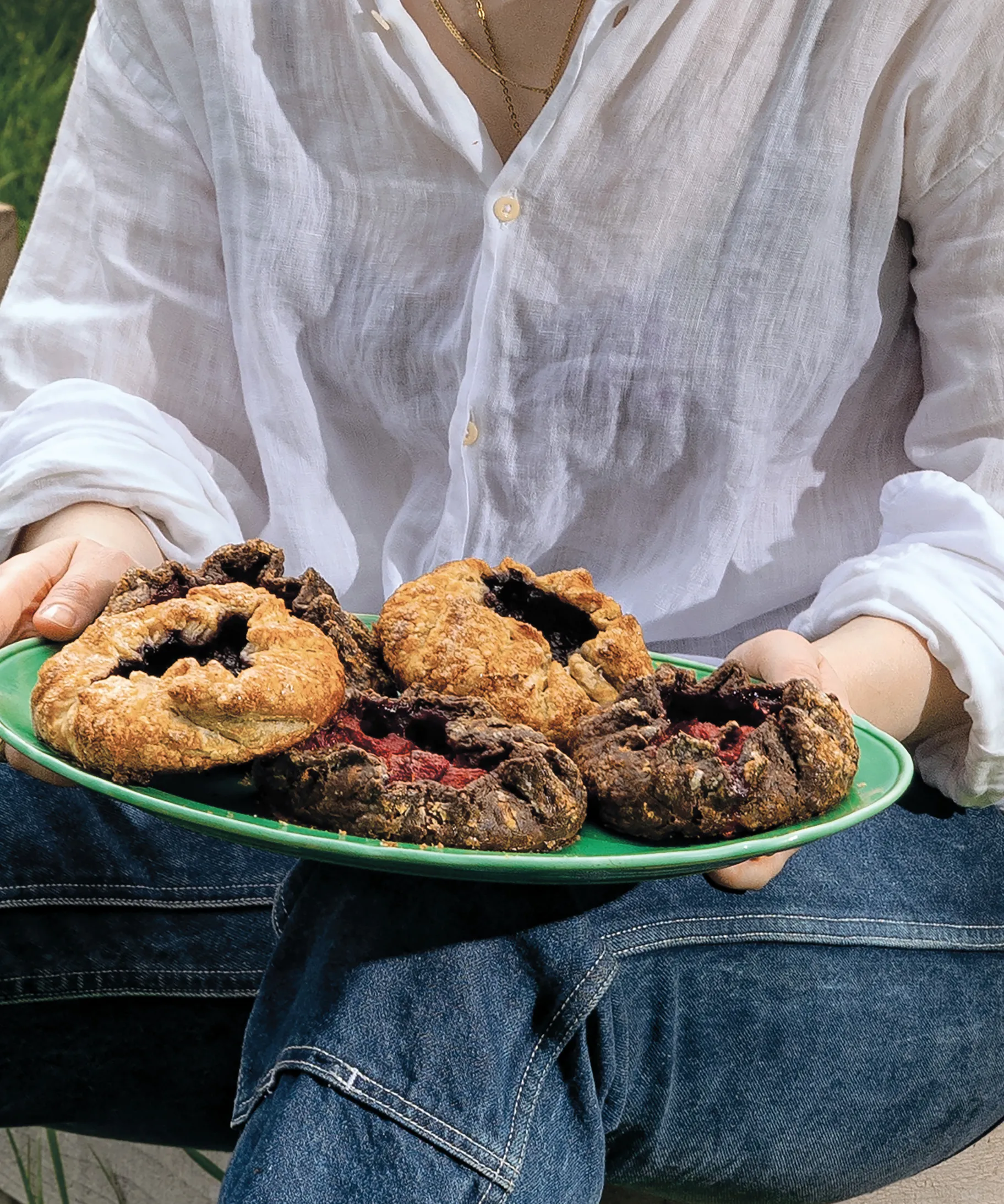
Galettes don’t have to be sweet. They can be savory too. Photo by Jessica Marx.
Can you speak briefly to the riffability of galettes versus pies?
Absolutely. Smack within the middle of my book, I have a recipe, or kind of a recipe talk-through, so to speak, called the Anything Goes Galette. I basically give the reader a formula with rough measurements for a sweet galette or a savory galette. But you really can do whatever you want to a galette. Even if you’re working from a recipe, no lemon juice? Use grapefruit juice. Use vinegar. You run out of all-purpose flour? You can throw a little whole wheat flour into your crust. Of course, measurements are incredibly important but when it comes to the actual content, galettes are so forgiving.
Do you always bake them on a sheet pan? I started pretty recently, baking some galettes in a pie pan so I had a little bit of structure to maybe fit a little bit like more fruit in there. Do you ever use a different kind of pan?
Absolutely, I bake them in springform cake pans to be super tall. Those, I actually use the full double crust recipe and I make these really lofty, almost diner cake, layer cake, big galettes. But I also bake them in fluted tart pans. I bake them in a cast iron skillet, pie plates. Again, we’re continuing to speak to the riffability of a galette.
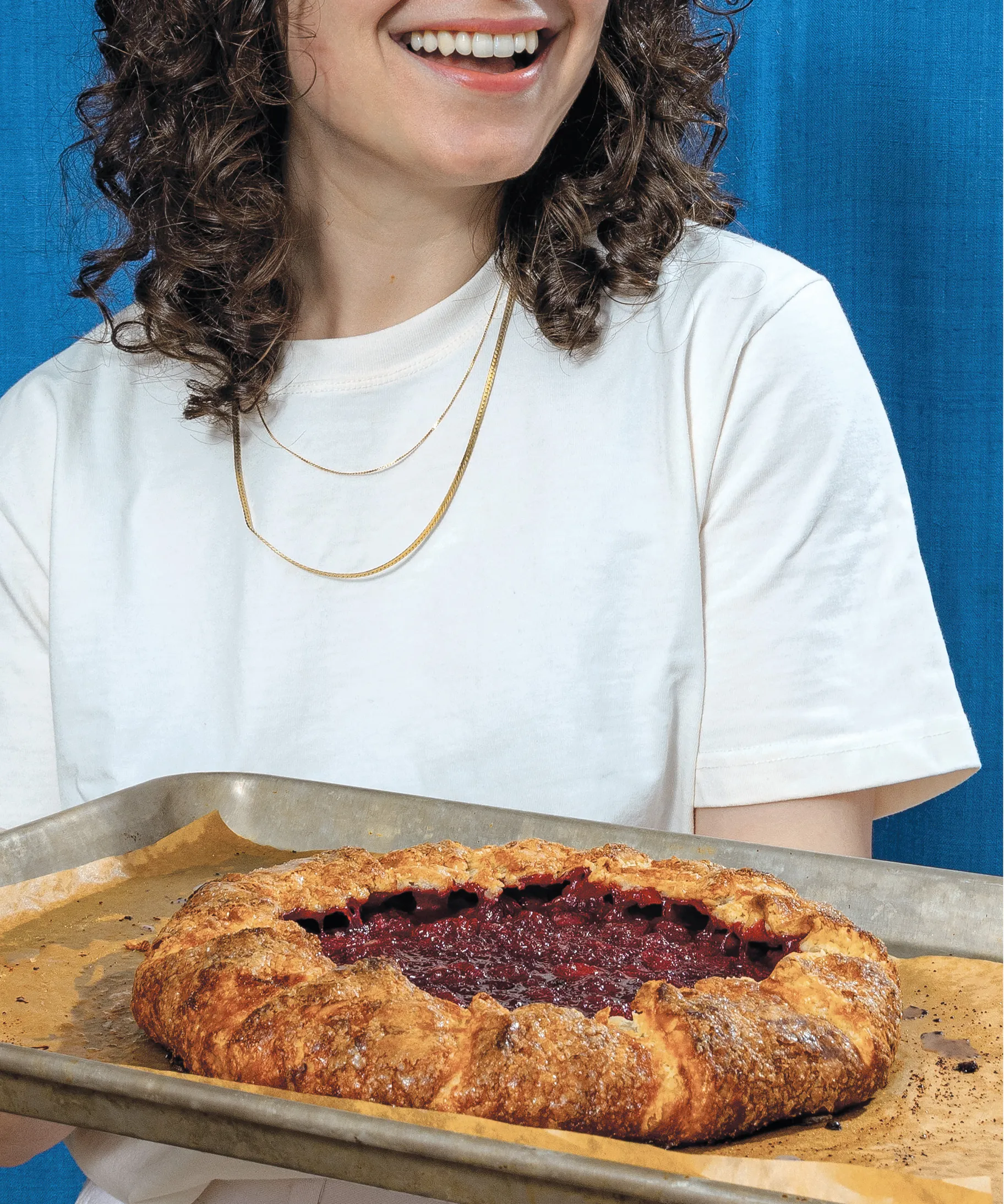
Rebecca Firkser holds up her plum galette. Photo by Jessica Marx
Is there one kind of dough that works best for galettes?
Oh, gosh, for my book, yes, it is A Good Crust Recipe for my flaky short crust pastry, which is essentially an even flakier riff on a pat brise. I personally absolutely love a shatteringly crisp dough to contrast with the sweet, soft, mushy fillings. For me, I often want my pie dough to almost be puff pastry. So I’m just skirting the line between the difference between a pie crust and a puff pastry, I would say.
You have several variations on your best crust. If I do a speed round of doughs, can you tell me what filling each pairs best with?
Oh, sure, fun. Okay.
Cornmeal.
Tomato, heirloom tomato, and the spices.
Buckwheat.
I’m gonna go with the sugared and peppered plum for the buckwheat.
Cocoa.
Ooh, a walnut or pecan frangiapane filling with chocolate and nuts in the cocoa crust.
That sounds so good. And then you also have a peppery dough.
Yes, that one’s fantastic with the sharp cheddar and apple galette.
I love that. Let’s talk about fillings. It’s summer, and I really love your galette seasonality guide.
Thank you.
Circling back to plums, I always think they’re the sleeper stone fruit for galettes. Describe your Sugared and Peppered Plum galette.
I really think that plums belong in galettes. I think they’re one of the most special fruits because they somehow manage to be tender and sweet. They just manage to hold their shape in such a fantastic way that they are really excellent in the pastry. And then I really love plum salads. So this is sort of a roundabout way to my inspiration. It started out with a plum salad that I was eating with pepper and tarragon. Then I was like, what if I did this in a galette filling and I made it more of a dessert, amped up the sugar, but kind of embraced that savory quality?
So we have the black pepper in there. We have the tarragon. Herbs are so lovely in fruit but you don’t often see herbs in a sweet galette. And then I decided to have a little more fun with it and throw in a little bit of dry vermouth, and then a little sprinkle of fennel seed around the edges. Then my favorite part of it is I really like this galette topped with shaved parmesan.
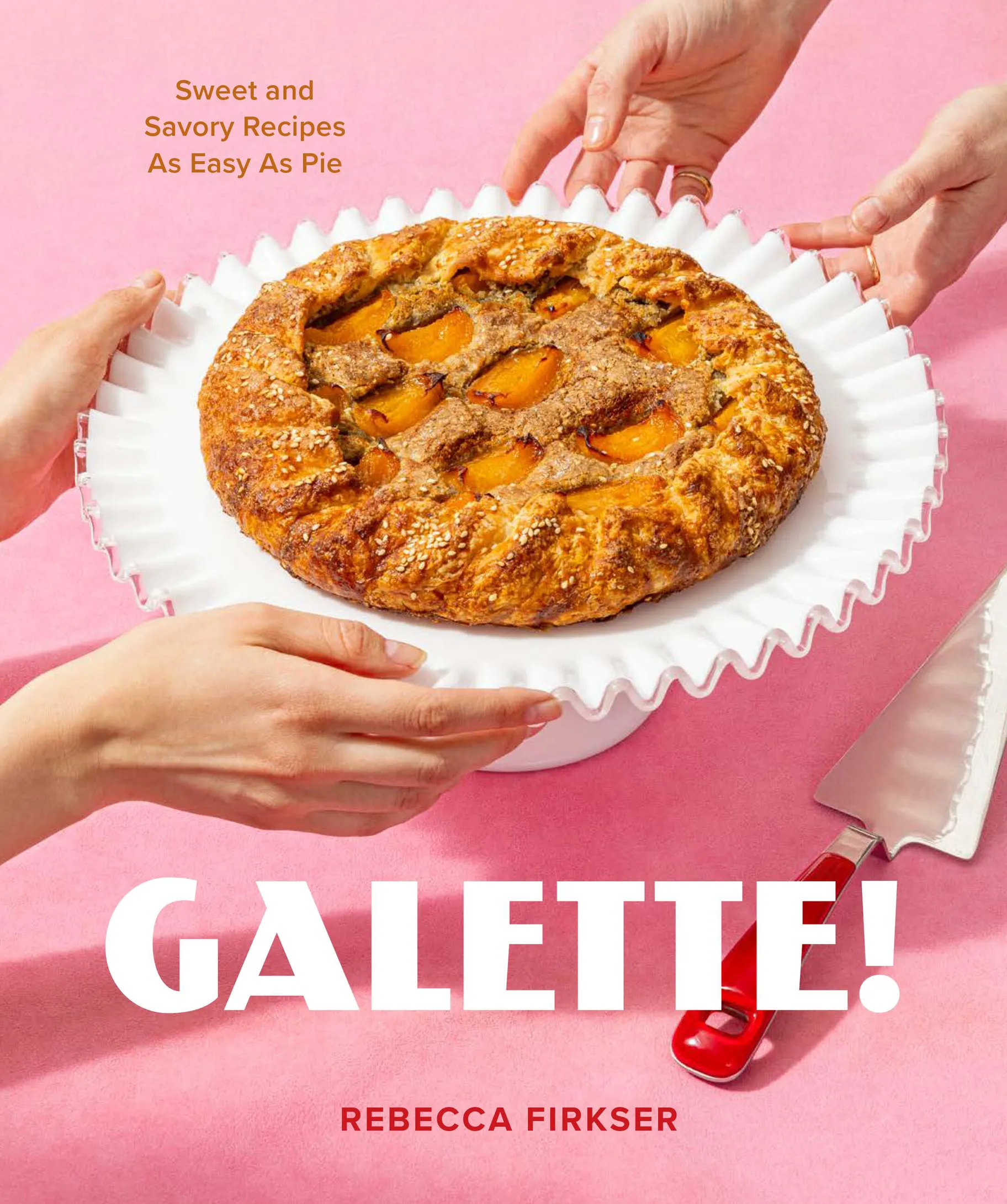
“Galette!” by Rebecca Firkser (Artisan Books). Copyright © 2025. Photographs by Jessica Marx.
The thing about galettes is that they share DNA with both pies and tarts but certain fillings don’t work as well in pies like frangipane because a pie is so much thicker. Yet frangipane pairs so beautifully with stone fruit. What suggestions do you have for a galette that includes stone fruit and some kind of frangipane?
You really can’t beat an apricot galette with a seedy frangipane. It’s either sunflower seeds or pepitas and tahini mixed up into a frangipane. It’s just enough fruit and you’re getting that nuttiness and that richness from the frangipane. I think that makes it just a little bit more special. It’s almost like eating a fancy breakfast pastry. I hope people will make it, and probably with it being on the cover that gives it a little bit of a push.
Yeah, it’s quite beautiful. For something savory, I really love fennel, and you have these very pretty individually sized galettes that combine both roasted and raw fennel. Could you describe them for us?
Oh, my gosh. I’m so happy you noticed those. That was actually one of the first round of recipes I did, but that was inspired by one of my favorite salads from Ultra Paradiso in Manhattan. It is just a gorgeous crunchy fennel, olive, nuts, and cheese salad. I was like, this would be so phenomenal wrapped in a little buttery crust. You can take a disc of the regular dough and you can cut it into quarters and make these charming little dessert plate-sized galettes that I feel are so special to serve, maybe at a dinner party for a little appetizer. For me, I think the only thing better than raw fennel is roasted fennel, and then it gets this shower of toasted hazelnuts on top, which is really, really special,
And there’s cheese in there as well, right?
Yes, yes, there’s really salty pecorino cheese. Obviously one could use parm, if that’s what they have, but I’m really always trying to sneak pecorino in because I feel like it’s such a wonderful alternative to parm. It’s a little bit funkier, little bit sharper, and it really pairs so wonderfully with roasted veg.
What I really loved about this particular galette is the fact that you do have the fennel that cooks along with the tart and the cheese, and then when you take it out, you put more of the salad on top to finish it off. It’s quite beautiful and you must get that wonderful counterpoint of texture, of the raw and the roasted.
Yes, exactly. By holding back on some of that filling, you get the best of both worlds in the fennel department.
Okay, so leave us with one more tip, just a little nugget.
I think the biggest thing that people tell me is they’re afraid of pastry. So I would say my one last galette-making tip is really when you’re working the butter into the flour mixture, you want to go ahead and work it in more than you think. You don’t want to completely work it in until you have cookie dough. But I think people are so timid about their pastry that they tend to leave it alone a little too much. I like to say that you want to leave some pieces of butter a little bit bigger, like maybe the size of a cannellini bean, and then other pieces you want to get smaller, sort of the size of a lentil. Those bigger pieces are going to puff up and help with the flakiness, but to keep the dough together, you really want to work that butter into the flour.
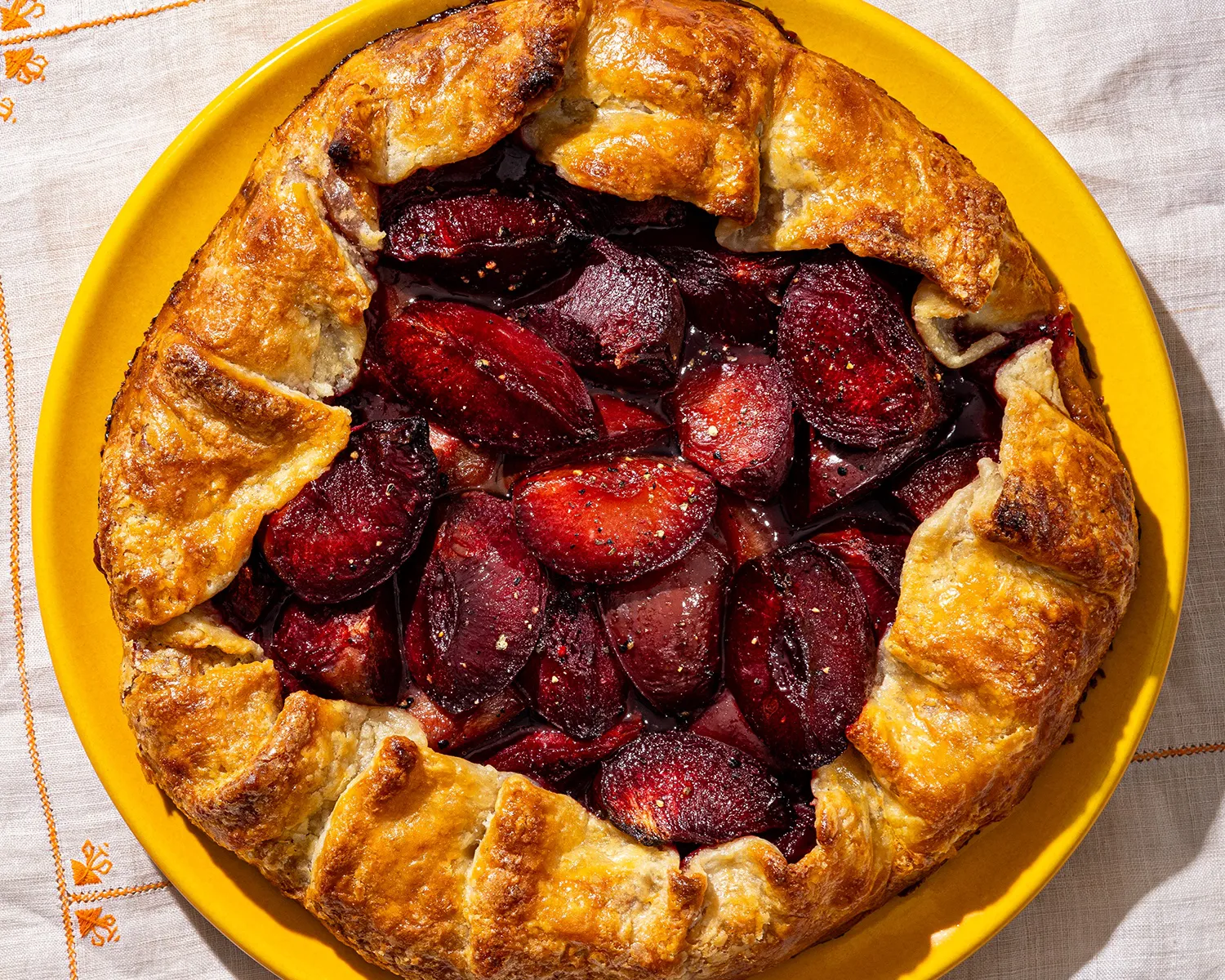
“I really think that plums belong in galettes,” says Rebecca Firkser, who developed the recipe for this Sugared and Peppered Plum Galette. Photo by Jessica Marx.
Sugared and Peppered Plum Galette
Serves 6 to 8
Plums just belong in galettes. The tart, floral orbs practically beg to be swaddled in buttery pastry. The beet-red flesh of Black Splendor plums (which you can find at the supermarket in season) is especially gorgeous when it comes to contrasting color with the crust. But why not play around with a handful of varieties if you can find them? Whichever plums you choose, dress them with black pepper and a splash of herbal dry vermouth.
Call it gilding the lily, but instead of ice cream or whipped cream, a slice is excellent topped with freshly shaved Parmesan and a drizzle of honey in addition to the grassy olive oil.
Ingredients
- 2 pounds (910 g) fresh plums (8 to 14), pitted and halved (quartered if larger than 2 inches/5 cm)
- ⅓ cup (65 g) sugar, plus more for sprinkling
- 2 tablespoons chopped fresh tarragon (optional)
- 1 tablespoon dry vermouth or apple cider vinegar
- 1 tablespoon cornstarch
- ¾ teaspoon coarsely ground black pepper
- ½ teaspoon Diamond Crystal or ¼ teaspoon Morton kosher salt
- 1 standard disk A Good Crust (page 27)
- Egg wash: 1 large egg, beaten Fennel seeds (optional)
- Good extra-virgin olive oil (optional), for serving
Instructions
-
Preheat the oven to 425°F (220°C) with a rack positioned in the center. Line a sheet pan with parchment paper.
-
In a large bowl, toss together the plums, sugar, tarragon (if using), vermouth, cornstarch, pepper, and salt.
-
Roll the dough into a round and set it on the lined sheet pan using the Basic Method (page 34).
-
Spoon the filling into the crust, leaving a 2-inch (5 cm) border. Fold the edges of the crust over the filling toward the center, overlapping and pleating as desired. Freeze the galette
on the sheet pan for 10 minutes. -
Remove the galette from the freezer and brush the egg wash over the exposed crust. Sprinkle fennel seeds (if using) and more sugar over the crust.
Excerpted from Galette! by Rebecca Firkser (Artisan Books). Copyright © 2025. Photographs by Jessica Marx.
A Good Crust
Makes 2 standard disks or 1 XL disk
A galette is essentially half crust and half filling, so the dough’s flavor is of the utmost importance. Butter, as opposed to shortening or another fat, makes the richest, most flavorful pastry. Sugar balances the salt and fat and aids a bit with browning — include it for sweet and savory galettes alike. Add a water-vinegar mixture by the splash for hydration (see page 28). Folding the dough over itself a few times (similar to a technique known as turning, more commonly found in pastry recipes like croissants or puff pastry) brings the mixture together and makes an extra-flaky crust.
The butter must stay cold in order for the dough to maintain its structure, then slowly melt and puff in the oven. To ensure this, chill the wet ingredients before they’re incorporated and bring the dough together quickly. It’s not a race, but don’t stop for a phone call halfway through. Save that pause for after you’ve wrapped up the dough, when it absolutely needs at least 2 hours’ rest to relax and hydrate completely before being rolled out.
This recipe makes enough dough for 2 standard galettes (or 4 tiny ones per disk of dough). Make one galette today, freeze a disk of dough for later. Alternatively, combine the entire batch of dough into one “XL” crust, for a sheet pan–sized slab or an extra-tall galette baked in a springform pan.
You can use this dough to make any galette in this book, but if you’re interested in going the extra mile with a flavored crust, see the Variations (page 39).
Ingredients
- 1/2 cup (115 g) water
- 1 tablespoon apple cider vinegar
- 2 3/4 cups (345 g) spooned and leveled all-purpose flour, plus more as needed
- 1 tablespoon sugar
- 1 1/2 teaspoons Diamond Crystal or ¾ teaspoon Morton kosher salt
- 2 1/2 sticks (10 ounces/285 g) unsalted butter, cut into 1/2-inch (13 mm) cubes, chilled
Instructions
-
In a liquid measuring cup or a small bowl, combine the water and the vinegar. Place this in the freezer while you work on the next steps.
-
In a large bowl, use your fingers or a fork to combine the flour, sugar, and salt.
-
Add the butter to the large bowl and use your fingers or a fork to gently toss around the butter to coat it in the flour mixture. Use your fingers to smash and rub the butter into the flour mixture until it forms flat pieces mostly the size of cannellini beans (about 3/4 inch/2 cm) with some smaller (think chickpeas and lentils; about 1/2 and 1/4 inch/13 and 6 mm). The mixture should still look dry and crumbly.
-
Remove the water-vinegar mixture from the freezer. Drizzle half of the water-vinegar mixture over the flour-butter mixture. Working from the bottom of the bowl up, use your fingers or a fork to gently toss the mixture together, as if you were tossing a salad. Drizzle over another splash of the water-vinegar mixture and toss. Continue to drizzle and toss until a shaggy, chunky mixture forms. It should not be completely combined yet, but there also should be no totally dry areas of flour (look for pebbles of moistened flour, not pure powder).
You may not need the full amount of water-vinegar mixture. When in doubt, err on the dry side: You can always add liquid, but you can’t take it away. -
Here’s how to know if you’re in a good place: Pick up a handful of the mixture and squish it. It should mostly hold its stuck-together shape; if not, drizzle an additional 1 teaspoon water-vinegar mixture on the driest areas and toss again, repeating until it holds together.
-
Dump the mixture onto a clean work surface and use your hands to pat it together into a rectangular mass about 1 inch (2.5 cm) thick. If you find any more areas that look totally dry, drizzle them with another 1 teaspoon water-vinegar mixture.
-
Use your hands or a bench scraper to fold the mass of dough over itself. Press down the dough until it’s about 1 inch (2.5 cm) thick again. (The dough shouldn’t be moist or sticky, but if so, sprinkle it with a bit of flour as you fold.) Repeat folding and pressing down the dough two or three times. As you fold the dough over itself, the shaggy mass will form into a cohesive dough (this is also going to help the crust bake off extra-flaky). The butter should not blend all the way in, and the surface of the dough should look like marble or wood grain.
-
If making a standard disk (check your galette recipe): Divide the dough in half, placing each half on a piece of plastic wrap. If making an XL disk (check your galette recipe): Place the entire slab of dough on a piece of plastic wrap.
-
Wrap the dough in the plastic wrap, then press it into a round or rectangle (see Note) about ¾ inch (2 cm) thick. Refrigerate for at least 2 hours and up to 5 days. (Alternatively, freeze for up to 3 months; when you’re ready to bake, see How to Thaw Frozen Galette Dough, page 33.)
Excerpted from Galette! by Rebecca Firkser (Artisan Books). Copyright © 2025. Photographs by Jessica Marx.

